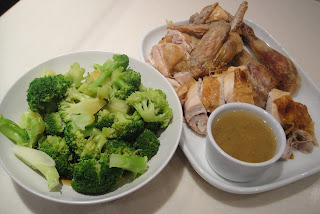The dish was slightly sharp, probably due to too much lemon juice. Next time I might try red wine or balsamic vinegar as a replacement.
Ingredients
- Approx. 400g of Jamie Oliver's simple tomato sauce
- A handful of prawns, peeled and de-veined
- 1 heaped dessert spoon of pancetta cubes, or sliced streaky bacon
- 200g new potatoes, washed and sliced at 3mm thickness
- 1 courgette, half-peeled (for the stripy effect) and sliced diagonally at 3mm thickness
- A tiny squeeze of lemon juice
- Handful of fresh, torn basil leaves
- (Optional) Grated hard cheese (I used cheddar) to serve
- Olive oil for frying
- Ground black pepper to taste
Serves 2
Instructions
- Heat the oil in a large, heavy-bottomed pan. Add the pancetta cubes and shake around until browned
- Add the sliced new potatoes and stir occasionally for 2-3 minutes - let sit in the pan to brown
- Add the courgettes and stir-occasionally for 2-3 minutes, browning nicely
- Add the tomato sauce and a tiny squeeze of lemon juice, and the black pepper. Turn the heat to low, cover and simmer for 5 minutes
- Add the prawns, replace the cover and simmer for another few minutes, until the prawns are just cooked
- Add the basil leaves, stir and remove from the heat. Serve in warmed serving bowls, with a little grated cheese on top
 |
| One-Pan Prawns with Potatoes and Courgettes |





















